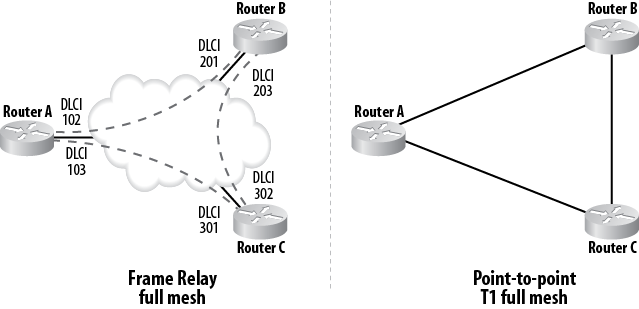Frame Relay Network Design
Frame Relay links are more flexible than point-to-point links, because multiple links can be terminated at a single interface in a router. This opens up design possibilities allowing connectivity to multiple sites at a significant cost savings over point-to-point circuits.
Figure 23-5 shows three sites networked together with Frame Relay. On the left, Router B and Router C are both connected to Router A, but are not connected to each other. This design is often referred to as a partial mesh or hub and spoke network. In this network, Router B can communicate to Router C only through Router A.

Figure 23-5. Meshed Frame Relay networks
On the right side of Figure 23-5 is an example of a fully meshed network. The difference here is that all sites are connected to all other sites. Router B can communicate directly with Router C in the fully meshed network.
Meshed networks are not strictly the domain of Frame Relay. As you can see in Figure 23-6, a fully meshed network can easily be created with point-to-point T1s.

Figure 23-6. Frame Relay versus point-to-point T1 meshed networks
In a Frame Relay network like the one shown on the left side of Figure 23-6, each location needs a router that can support a single T1. Each PVC can be configured as a separate virtual ...
Get Network Warrior, 2nd Edition now with the O’Reilly learning platform.
O’Reilly members experience books, live events, courses curated by job role, and more from O’Reilly and nearly 200 top publishers.

